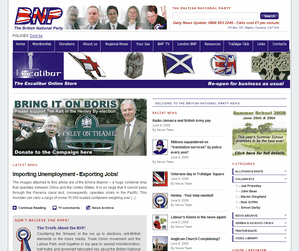
The Conservatives won plaudits for the MyConservatives social networking platform they launched at their annual conference; and now the LibDems are slowly getting their own Act together (ho ho). Labourspace remains a bit of a joke. But one UK political party has been quietly developing its own social network for a few months now, with a membership now well in excess of 4,000 – and impressive open-source technology to boot. It’s the BNP.
There was some amusement across the political divide a couple of weeks back, when the BNP unveiled a new website design bearing more than a mild resemblance to BarackObama.com. But I haven’t seen any reference to the addition (or perhaps more accurately, the increased visibility) of its social networking functions based on BuddyPress, the free WordPress add-on often described as ‘Facebook in a box’.
To date, the site has attracted 4370 members – not necessarily party members, as it’s an option (defaulting to ‘no’) on the sign-up form. And as its RSS feed shows, it’s a fairly busy site. Once you’ve joined, you can sign up to any of the 225 groups which attract your interest, many of which have memberships in the hundreds. You can fill out your member profile, as site admin Simon Bennett has done. And just like Facebook, you can look at his friends, the groups he’s joined, and what else he’s been up to on the site. (There’s also a live chat widget on the profile page, if you want to watch site members conversing in real time.)
Looking beyond their politics, if you can, it’s impressive stuff. The BNP’s web activity has long been cited as several times more popular than the other mainstream parties; and if you put any faith in Alexa rankings, it still leaves them for dead. Indeed, Alexa currently ranks the BNP’s site as the 753rd most popular in the UK. There are many possible reasons for this – the BNP’s lack of mainstream media exposure, the inclusion of those social functions within the main party site, possibly also deliberate efforts by party members to boost their rankings. But that doesn’t take away from the achievement.
The fact is, they’re building and nurturing an active online following, which will inevitably help them mobilise – and raise money – come the election. If the mainstream parties could boast such statistics, we’d be talking about a new media revolution in politics.

 Late last year, I
Late last year, I